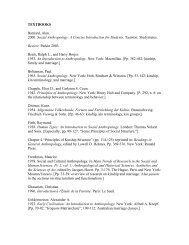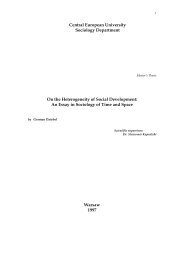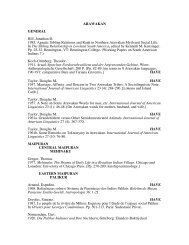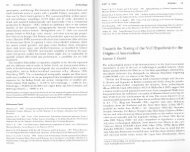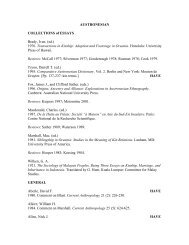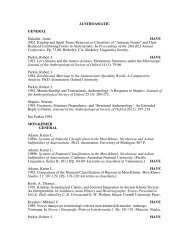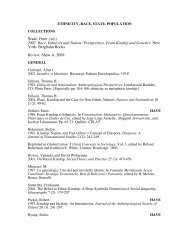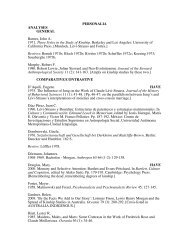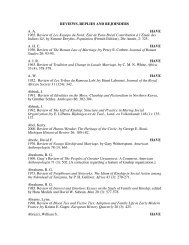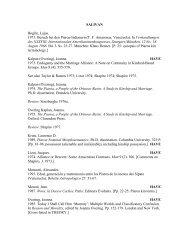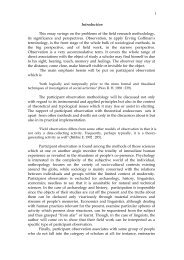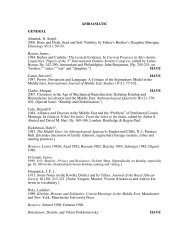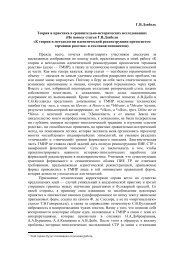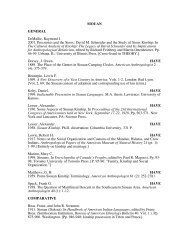FOLKLORE, LINGUISTICS, ONOMASTICS ... - Kinship Studies
FOLKLORE, LINGUISTICS, ONOMASTICS ... - Kinship Studies
FOLKLORE, LINGUISTICS, ONOMASTICS ... - Kinship Studies
Create successful ePaper yourself
Turn your PDF publications into a flip-book with our unique Google optimized e-Paper software.
<strong>FOLKLORE</strong><br />
<strong>LINGUISTICS</strong><br />
GENERAL<br />
<strong>FOLKLORE</strong>, <strong>LINGUISTICS</strong>, <strong>ONOMASTICS</strong><br />
Agha, Asif.<br />
2006. Norm and Trope in <strong>Kinship</strong> Behavior. Texas Linguistics Forum 49: 1-21.<br />
Agha, Asif.<br />
2007. Language and Social Relations. Cambridge: Cambridge University Press. [Pp. 340-<br />
385: “Norm and Trope in <strong>Kinship</strong> Behavior.”]<br />
Arutyunov, Sergei. HAVE<br />
1980. Ethnography and Linguistics. In Soviet and Western Anthropology, edited by<br />
Ernest Gellner. Pp. 257-263. Duckworth.<br />
Boas, Franz.<br />
1911. Introduction. In Handbook of American Indian Languages, edited by Franz Boas.<br />
Vol. 1. Pp. 5-83. Washington: Government Printing Office. (Bulletin of the Bureau of<br />
American Ethnology 40.) [Pp. 72-73: the linguistic and the social in kin terminologies.]<br />
Brown, Cecil H., and Stanley R. Witkowski. HAVE<br />
1981. Figurative Language in a Universalist Perspective. American Ethnologist 8 (3):<br />
596-615.<br />
Casselberry, Samuel E. HAVE<br />
1973. Familingual and Familinear Relationships: Companion Terms and Concepts.<br />
American Anthropologist 75 (1): 310-312.<br />
Chatterjee, Pranab. HAVE<br />
1972. Familingual and Familinear Relationships: Two Patterns of Control by the<br />
Invoking of Family Roles. American Anthropologist 74 (1-2): 231-241.<br />
Chatterjee, Pranab. HAVE<br />
1974. Familingual and Familinear Relationships: Some Contexts of Negation or Denial.<br />
American Anthropologist 76 (4): 847-849.<br />
Horton, Robert. HAVE<br />
1979. Material-Object Language and Theoretical Language: Towards a Strawsonian<br />
Sociology of Thought. In Philosophical Disputes in the Social Sciences, edited by S. C.<br />
Brown. Pp. 197-224. Sussex: Harvester Press, and New Jersey: Humanities Press. [While<br />
not directly on kinship, this article makes a claim about the varying degrees of conceptual<br />
elaboration of human vs. natural worlds in Western and tribal societies.]<br />
Kroeber, Alfred L. HAVE<br />
1941. Some Relations of Linguistics and Ethnology. Language 17 (4): 287-291.<br />
Lamb, Sydney M. HAVE<br />
1965. <strong>Kinship</strong> Terminology and Linguistic Structure. American Anthropologist 67 (5, pt.<br />
2): 37-64.
Lévi-Strauss, Claude. HAVE<br />
1951. Language and the Analysis of Social Laws. American Anthropologist 53 (2): 155-<br />
163.<br />
Translated into the French as “Langage et Société” in: Anthropologie Structurale, by<br />
Claude Lévi-Strauss. Pp. 63-75. Paris: Librarie Plon, 1958.<br />
Lévi-Strauss, Claude. HAVE<br />
1953. Chapter I. (Linguistics and Anthropology). In Results of the Conference of<br />
Anthropologists and Linguists, Memoir 8: 1-10. Baltimore: Waverley Press.<br />
Translated into the French as “Linguistique et Anthropology” in: Anthropologie<br />
Structurale, by Claude Lévi-Strauss. Pp. 77-91. Paris: Librarie Plon, 1958.<br />
Lévi-Strauss, Claude.<br />
1958. Postface aux chapitres III et IV. In Anthropologie Structurale, by Claude Lévi-<br />
Strauss. Pp. 93-110. Paris: Librarie Plon. [Postscript to Lévi-Strauss 1951 and Lévi-<br />
Strauss 1953.]<br />
Lounsbury, Floyd G.<br />
1968. Linguistics and Psychology. In Psychology: A Study of a Science. Vol. 6, edited by<br />
Sigmund Koch. Pp. 552-582. New York: McGraw & Hill. [Pp. 55-58: on kin<br />
terminologies as systems of classification.]<br />
Reprinted in: Readings in the Sociology of Language, edited by Joshua A. Fishman. pp.<br />
38-67. The Hague: Mouton.<br />
Merten, Stephen. HAVE<br />
1994. Die sprachliche und gesellschaftliche Interpretation von Welt: Farben und<br />
Verwandtschaftsbezeichnungen. Sociologus 44 (2): 149-165. [Cross-listed in<br />
AUSTROASIATIC and INDO-EUROPEAN.]<br />
Moore, Omar K., and David L. Olmsted. HAVE<br />
1952. Language and Professor Levi-Strauss. American Anthropologist 54 (1): 116-119.<br />
[Critique of Lévi-Strauss 1951.]<br />
Overing, Joanna.<br />
1985. Today I Shall Call Him ‘Mummy’: Multiple Worlds and Classificatory Confusion.<br />
In Reason and Morality, edited by Joanna Overing. Pp. 152-179. London and New York:<br />
Tavistock Publications. [Cross-listed in SALIVAN.]<br />
Spence, N.<br />
1964. The Basic Problem of Ethnolinguistics. Archivum Linguisticum 16 (2): 145-156. [A<br />
review of neo-Humboldtian linguistics, with some discussion of kin terms in the context<br />
of the relativity hypothesis.]<br />
ACQUISITION<br />
FIRST LANGUAGE<br />
Anglin, Jeremy M.<br />
1977. Word, Object, and Conceptual Development. New York: W. W. Norton. [P. 34: kin<br />
terms like mommy and daddy as the earliest words acquired by children.]<br />
Anglin, Jeremy M.
1995. The Order of Acquisition of Object Names and Kin Terms During Childhood. In<br />
<strong>Studies</strong> in Applied Psychosemiotics, edited by Tatiana Slama-Cazacu, Renzo Titone, and<br />
Marcel Danesi. Pp. 19-52. Toronto, ON: Toronto Semiotic Circle, Victoria College,<br />
University of Toronto.<br />
Baldwin, Lawrence A.<br />
1972. Children’s Structuring of American-English <strong>Kinship</strong>. Ph.D. dissertation. Harvard<br />
University.<br />
Benson, N., and J. Anglin.<br />
1987. Children’s Knowledge of English Kin Terms. First Language 7: 41-66.<br />
Berthoud-Papandropoulou, I., and E. Thommen.<br />
1993. Acquisition des relations de parenté chez l’enfant, aspects logiques, lexicaux et<br />
énonciatifs. Archives de Psychologie 62: 307-323.<br />
Broeder, Peter, and Guus Extra.<br />
1991. Acquisition of <strong>Kinship</strong> Reference: A Study on Word Formation Processes of Adult<br />
Language Learners. International Journal of Applied Linguistics 1: 209-227. [Secondlanguage<br />
acquisition; adult Turkish and Moroccan immigrants learning Dutch.]<br />
Carter, Anthony T. HAVE<br />
1984. The Acquisition of Social Deixis: Children’s Usages of Kin Terms in Maharashtra,<br />
India. Journal of Child Language 11 (1): 179-201.<br />
Chambers, James C., and Nicholas Travuchis. HAVE<br />
1976. Kids and Kin: Children’s Understanding of American Kin Terms. Journal of Child<br />
Language 3: 63-80.<br />
Clark, Eve V.<br />
1993. The Lexicon in Acquisition. Cambridge: Cambridge University Press. [Pp. 28, 30:<br />
kin terms among the first words of a child.]<br />
Clausen, M. T. W.<br />
1975. An Anthropological and Psychological Investigation of Use and Understanding of<br />
Kin Terms in English Children. M.A. thesis. University of London.<br />
Clendenen, Nancy M.<br />
1974. Age and Sex Differences in Learning American Kin Terminology: A Preliminary<br />
Study. Anthropological Papers of the University of Arkansas 1 (1): 34-42.<br />
Danziger, Kurt. HAVE<br />
1957. The Child’s Understanding of <strong>Kinship</strong> Terms: A Study in the Development of<br />
Relational Concepts. Journal of Genetic Psychology 91: 213-232.<br />
Deutsch, Werner. HAVE<br />
1979. The Conceptual Impact of Linguistic Input: A Comparison of German Family-<br />
Children’s and Orphans Acquisition of <strong>Kinship</strong> Terms. Journal of Child Language 6:<br />
313-327.<br />
Elkind, David. HAVE<br />
1962. Children’s Conception of Brother and Sister: Piaget Replication Study V. Journal<br />
of Genetic Psychology 100: 129-136.
Ervin-Tripp, Susan.<br />
1976. Speech Acts and Social Learning. In Meaning in Anthropology, edited by Keith H.<br />
Basso and Henry A. Selby. Pp. 123-153. Albuquerque: University of New Mexico Press.<br />
[Especially pp. 142-143: kin terms in the child’s address system.]<br />
Ferguson, Charles A. HAVE<br />
1977. Baby Talk as a Simplified Register. In Talking to Children: Language Input and<br />
Acquisition. Papers from a Conference Sponsored by the Committee on Sociolinguistics<br />
of the Social Science Research Council (USA), edited by Catherine E. Snow and Charles<br />
A Ferguson. Pp. 209-235. Cambridge: Cambridge University Press. [P. 220: baby kin<br />
terms vs. adult kin terms (example from Japanese).]<br />
Gamble, Thomas J.<br />
1982. Cognizing the Social World: An Investigation into the Emergence of Generative<br />
Relational Structures for Kin Inference. Ph.D. dissertation. Syracuse University. 211 P.<br />
Gentner, Dedre, and Lera Boroditsky. HAVE<br />
2001. Individuation, Relativity and Early Word Learning. In Language Acquisition and<br />
Conceptual Development, edited by Melissa Bowerman and Stephen C. Levinson. Pp.<br />
215-256. Cambridge, UK: Cambridge University Press.<br />
Goldfield, Beverly A; Snow, Catherine E.<br />
1992. ‘What’s Your Cousin Arthur’s Mommy's Name?’: Features of Family Talk about<br />
Kin and Kin Terms. First Language 12 (2): 187-205.<br />
Greenfield, Patricia M. HAVE<br />
1973. Who Is ‘dada’?: Some Aspects of the Semantic and Phonological Development of<br />
a Child’s First Words. Language and Speech 16: 34-43.<br />
Greenfield, Patricia M.<br />
1983. Ontogenesis, Use, and Representation of Cultural Categories: A Psychological<br />
Perspective. In The Sociogenesis of Language and Human Conduct, edited by Bruce<br />
Bain. Pp. 109-130. New York: Plenum. [Includes kin terms.]<br />
Greenfield, Patricia M., and Carla P. Childs. HAVE<br />
1977. Understanding Sibling Concepts: A Developmental Study of Kin Terms in<br />
Zinacantan. In Piagetian Psychology: Cross-Cultural Contributions, edited by Pierre R.<br />
Dasen. Pp. 335-358. New York: Gardner Press.<br />
Haviland, Susan E., and Eve V. Clark.<br />
1973. “This Man’s Father Is My Father’s Son”: A Study of the Acquisition of English<br />
Kin Terms. Papers and Reports on Child Language Development 5: 1-30. Stanford, CA.<br />
Haviland, Susan E., and Eve V. Clark. HAVE<br />
1974. ‘This Man’s Father Is My Father’s Son’: A Study of the Acquisition of English Kin<br />
Terms. Journal of Child Language 1: 23-47.<br />
Hirschfeld, Lawrence A. HAVE<br />
1989. Rethinking the Acquisition of <strong>Kinship</strong> Terms. International Journal of Behavioral<br />
Development 12 (4): 541-568.<br />
Hirschfeld, Lawrence A. HAVE<br />
1994. On Childhood Cognition and Social Institutions. Man 29 (4): 976-977.
Hirschfeld, Lawrence A. HAVE<br />
2001. On a Folk Theory of Society: Children, Evolution, and Mental Representations of<br />
Social Groups. Personality and Social Psychology Review 5 (2): 107-117.<br />
Jordan, Valerie B.<br />
1977. Conserving <strong>Kinship</strong> Concepts: A Developmental Study in Social Cognition. Ph.D.<br />
dissertation (Psychology). City University of New York. 152 P.<br />
Jordan, Valerie B.<br />
1980. Conserving <strong>Kinship</strong> Concepts: A Developmental Study in Social Cognition. Child<br />
Development 51 (1): 146-155.<br />
Keil, Frank C., and Nancy Batterman.<br />
1984. A Characteristic-to-Defining Shift in the Development of Word Meaning. Journal<br />
of Verbal Learning and Verbal Behavior 23: 221-236. [Includes the discussion of the two<br />
stages in the acquisition of meaning of kin terms.]<br />
Kernan, Keith T.<br />
1967. Parental Baby Talk. In Field Manual for Cross-Cultural Study of the Acquisition of<br />
Communicative Competence, edited by Daniel I. Slobin. Pp. 42-45. Berkeley: University<br />
of California Press.<br />
Kuczaj, Stan A.<br />
1984. Development of the <strong>Kinship</strong> Term Semantic System in English Speaking Children.<br />
In Proceedings of the Second International Congress for the Study of Child Language,<br />
Vol. II, edited by Carol L. Thew and Carolyn E. Johnson. Pp. 194-203. Lanham, MD:<br />
University Press of America.<br />
Landau, Barbara. HAVE<br />
1982. Will the Real Grandmother Please Stand Up? The Psychological Reality of Dual<br />
Meaning Representations. Journal of Psycholinguistic Research 11 (1): 47-62.<br />
LeVine, Robert A., and Douglass R. Price-Williams.<br />
1974. Children's <strong>Kinship</strong> Concepts: Cognitive Development and Early Experience among<br />
the Hausa. Ethnology 13 (10: 25-44.<br />
Luong, Hy Van. HAVE<br />
1986. Language, Cognition, and Ontogenetic Development: A Reexamination of Piaget’s<br />
Premises. Ethos 14 (1): 7-46. [Kin term acquisition as exemplified by Vietnamese. Crosslisted<br />
in AUSTROASIATIC.]<br />
Macaskill, Ann. HAVE<br />
1981. Language Acquisition and Cognitive Development in the Acquisition of <strong>Kinship</strong><br />
Terms. British Journal of Educational Psychology 51 (3): 283-290.<br />
Macaskill, Ann. HAVE<br />
1982. Egocentricity in the Child and Its Effect on the Child’s Comprehension of Kin<br />
Terms. British Journal of Psychology 73: 305-311.<br />
Macaskill, Ann. HAVE<br />
1981. Language Acquisition and Cognitive Development in the Acquisition of <strong>Kinship</strong><br />
Terms. British Journal of Educational Psychology 51: 283-290.
Macaskill, Ann. HAVE<br />
1982. Egocentricity in the Child and Its Effect on the Child’s Comprehension of Kin<br />
Terms. British Journal of Psychology 73: 305-311.<br />
McLaughlin, B. et al.<br />
1983. Mothers' and Fathers’ Speech to Their Young Children; Similar or Different?<br />
Journal of Child Language 10: 245-252.<br />
Marinis, Theodore. HAVE<br />
1999. What Can the Acquisition of Proper Names and <strong>Kinship</strong> Terms Tell Us About the<br />
Acquisition of the DP. In Proceedings of CLS’ 99, edited by I. Barrière, S. Chiat, G.<br />
Morgan, and B. Wolf. London: City University Press.<br />
Milicic, Bojka.<br />
2011. Is There a <strong>Kinship</strong> Modukle?: Evidence from Children’s Acquisition of <strong>Kinship</strong><br />
Terms in Pitumarca, Peru. In <strong>Kinship</strong>, Language and Prehistory: Per Hage and the<br />
Renaissance in <strong>Kinship</strong> <strong>Studies</strong>, edited by Doug Jones and Bojka Milicic. Pp. 212-222.<br />
Salt Lake City: University of Utah Press.<br />
Nelson, Agatha P.<br />
1992. Is a Father a Daddy? A Developmental Study of Children’s Definitions of Parental<br />
<strong>Kinship</strong> Terms. Ph.D. dissertation. City University of New York.<br />
Piaget, Jean.<br />
1928. Judgment and Reasoning in the Child. Translated from the French by Marjorie<br />
Warden. New York: Harcourt, Brace; London: Kegan Paul, Trench, Trubner. [Pp. 62-<br />
129: acquisition of relational thought. Examples of kin terms.]<br />
Price-Williams, Douglass, Ormond W. Hammond, Ceel Edgerton, and Michael Walker.<br />
1977. <strong>Kinship</strong> Concepts among Rural Hawaiian Children. In Piagetian Psychology:<br />
Cross-Cultural Contributions, edited by Pierre R. Dasen. Pp. 296-334. New York:<br />
Gardner Press.<br />
Ragnarsdóttir, Hrafnhildur.<br />
1990. Systéme Patronimique et Construction des Relations de Parenté chez les Enfants<br />
Islandais. Ph. D. dissertation. Université de Provence Aix-Marseille.<br />
Ragnarsdóttir, Hrafnhildur.<br />
1993. Children’s Acquisition of <strong>Kinship</strong> Concepts: The Role of Language and of<br />
Cognitive Development. In 6 th International Congress for the Study of Child Language.<br />
Trieste Mosetti.<br />
Ragnarsdóttir, Hrafnhildur.<br />
1996. Children’s Acquisition of <strong>Kinship</strong> Concepts: A Cross-Linguistic Study. In 14 th<br />
Biennial Meetings of the International Society for the Study of Behavioral Development,<br />
Quebec City (Canada), 12-16 Aug 1996.<br />
Ragnarsdóttir, Hrafnhildur.<br />
1997. “Uncle Larus, Stefan’s Father, Isn’t He My Brother?” Children’s Acquisition of<br />
<strong>Kinship</strong> Concepts Nordisk Psykologi 49 (2): 136-158.<br />
Ragnarsdóttir, Hrafnhildur.
1999. The Acquisition of <strong>Kinship</strong> Concepts. In Language and Thought in Development:<br />
Cross-Linguistic <strong>Studies</strong>, edited by Peter Broeder and Jaap Murre. Pp. 73-94. Tübingen:<br />
Gunter Narr.<br />
Rips, Lance J., and Margaret E. Stubbs. HAVE<br />
1980. Genealogy and Memory. Journal of Verbal Learning and Verbal Behavior 19: 705-<br />
721.<br />
Rondal, J. A.<br />
1980. Fathers' and Mothers' Speech in Early Language Development. Journal of Child<br />
Language 7: 353-369.<br />
Rūke-Dravina, V.<br />
1976. ‘Mama’ and ‘Papa’ in Child Language. Journal of Child Language 3: 157-166.<br />
Swartz, Karyl, and Alfred E. Hall. HAVE<br />
1972. Development of Relational Concepts and Word Definition in Children Five<br />
Through Eleven. Child Development 43: 239-244. [Tests of the development of concepts<br />
“brother” and “having a brother.”]<br />
Thomson, Jean R., and Robin S. Chapman. HAVE<br />
1977. Who Is ‘daddy’ Revisited: The Status of Two-Year-Olds’ Over-Extended Words in<br />
Use and Comprehension. Journal of Child Language 4 (3): 359-375.<br />
SECOND LANGUAGE<br />
Alo, Moses A.<br />
1989. A Prototype Approach to the Analysis of Meanings of <strong>Kinship</strong> Terms in Non-<br />
Native English. Language Sciences 11 (2): 159-176.<br />
Broeder, Peter, and Guus Extra.<br />
1991. Acquisition of <strong>Kinship</strong> Reference: A Study on Word-Formation Processes of Adult<br />
Language Learners. International Journal of Applied Linguistics 1 (2): 209-227.<br />
APHASIA<br />
Gloning, Karl.<br />
1980. Paraphasien bei Verwandtschaftsbezeichnungen. In Paraphasie: Untersuchungen<br />
zum Problem Lexicalischer Fehlleistungen, herausgegeben von Karl Gloning und<br />
Wolfgang U. Dressler. Pp. 61-100. München: Fink.<br />
ARTIFICIAL LANGUAGES<br />
Proechel, Glen. HAVE<br />
1993. Extending Klingon <strong>Kinship</strong> Terms. HolQeD: The Journal of the Klingon Language<br />
Institute 2 (3): 6.<br />
BORROWING<br />
Haarmann, Harald,<br />
1988. Language in Ethnicity: A View of Basic Ecological Relations. Berlin: Mouton de<br />
Gruyter. [Pp. 179ff: “Borrowings in the lexical field of kinship terms,” with examples<br />
from Izhorian, German, English, Finnish, Roma and other languages.]
Review: Fayer 1988.<br />
CREOLE LANGUAGES<br />
Williams, J. P.<br />
1988. Women and <strong>Kinship</strong> in Creole Genesis. International Journal of the Sociology of<br />
Language 71: 81-89.<br />
GRAMMAR<br />
Aikhenvald, Alexandra.<br />
2000. Classifiers: A Typology of Noun Categorization Devices. Oxford: Oxford<br />
University Press. [Pp. 146: kinship possession; 82, 131, 141, 271-272, 280, 284, 305,<br />
306, 342, 353-354, 357-359: kinship as a semantic parameter in noun categorization; 41,<br />
64, 66, 131, 357: kin terms.]<br />
Amith, Jonathan D., and Thomas C. Smith-Stark. HAVE<br />
1994. Predicate Nominal and Transitive Verbal Expressions of Interpersonal Relations.<br />
Linguistics 32: 511-547.<br />
Barker, Chris.<br />
1995. Possessive Descriptions. Ph.D. dissertation. University of California, Santa Cruz.<br />
Barker, Chris.<br />
1995. Possessive Descriptions. Stanford: Center for the Study of Language and<br />
Information.<br />
Blake, Barry J.<br />
2001. Case. Cambridge: Cambridge University Press. [P. 122, 137-140: animacy<br />
hierarchy, namely pronouns > personal names > kin terms > animates > inanimates, and<br />
its impact on case marking, agreement, advancement, etc.]<br />
Broschart, J.<br />
2004. Possession (Linguistic). In International Encyclopedia of the Social and Behavioral<br />
Sciences: 11831-11834.<br />
Carlson, Robert, and Dorie Payne. HAVE<br />
1989. Genitive Classifiers. In Proceedings of the 4 th Annual Meeting of the Pacific<br />
Linguistics Conference. Pp. 87-119. Eugene, OR: Department of Linguistics, University<br />
of Oregon.<br />
Castillo, Juan C.<br />
2001. Thematic Relations Between Nouns. Ph.D. dissertation. University of Maryland at<br />
College Park. [Pp. 145-162: kinship possession.]<br />
Chappell, Hilary, and William McGregor. HAVE<br />
1989. Alienability, Inalienability and Nominal Classification. In Proceedings of the 15 th<br />
Annual Meeting of the Berkeley Linguistics Society, February 18-20, 1989, edited by<br />
Kara Hall, Michael Meacham, and Richard Shapiro. Pp. 24-36. Berkeley: Berkeley<br />
Linguistics Society.<br />
Chappell, Hilary, and William McGregor. HAVE<br />
1996. Prolegomena to a Theory of Inalienability. In The Grammar of Inalienability: A<br />
Typological Perspective on Body Part Terms and the Part-Whole Relation, edited by
Hilary Chappell and William McGregor. Pp. 3-30. Berlin and New York: Mouton de<br />
Gruyter.<br />
Cienki, Alan. HAVE<br />
1995. The Semantics of Possessive and Spatial Constructions in Russian and Bulgarian:<br />
A Comparative Analysis in Cognitive Grammar. Slavic and East European Journal 39<br />
(1): 73-114. [Pp. 81-82: “On the Semantics of Possession.” General discussion from the<br />
point of view of cognitive grammar. Includes kin terms.]<br />
Dahl, Östen, and Maria Koptjevskaja-Tamm. HAVE<br />
1998. Alienability Splits and the Grammaticalization of Possessive Constructions. In<br />
Papers from the 16 th Scandinavian Conference of Linguistics. Pp. 38-49. Turku:<br />
University of Turku.<br />
Dahl, Östen, and Maria Koptjevskaja-Tamm. HAVE<br />
2001. <strong>Kinship</strong> in Grammar. In Dimensions of Possession, edited by Irène Baron, Michael<br />
Herslund and Finn Sørensen. Pp. 201-225. Amsterdam and Philadelphia: John<br />
Benjamins.<br />
Dahl, Östen.<br />
2004. The Growth and Maintenance of Linguistic Complexity. Amsterdam: John<br />
Benjamins. [Pp. 148-153: kin terms and body parts as inalienably possessed.]<br />
Dixon, R. M. W.<br />
2004. Adjective Classes in Typological Perspective. In Adjective Classes: A Cross-<br />
Linguistic Typology, edited by R. M.W. Dixon and Alexandra Y. Aikhenvald. Pp. 1-49.<br />
Oxford: Oxford University Press. [P. 2: kin terms as nouns and as verbs.]<br />
Emeneau, Murray B. HAVE<br />
1950. Language and Non-Linguistic Patterns. Language 26 (2): 199-209. [<strong>Kinship</strong><br />
possession and kinship pronouns. Examples from Toda and Vietnamese.]<br />
Gerlach, Birgit. HAVE<br />
2002. Review of Vogel, Petra M. and Bernard Comrie (eds.), Approaches to the Typology<br />
of Word Classes. Berlin, New York: Mouton de Gruyter. <strong>Studies</strong> in Language 25 (3):<br />
663-679. [P. 667: summary of Evans 2002.]<br />
Evans, Nicholas. HAVE<br />
2000. <strong>Kinship</strong> Verbs. In Approaches to the Typology of Word Classes, edited by Petra M.<br />
Vogel and Bernard Comrie. Pp. 103-172. Berlin and New York: Mouton de Gruyter.<br />
Evans, Nicholas. HAVE<br />
2003. An Interesting Couple: The Semantic Development of Dyad Morphemes. Köln:<br />
Institut für Sprachwissenschaft, Universität zu Köln. (Arbeitspapier 47.) [Extensively on<br />
kin term dyads. Data from Australian, Oceanic and Khoisan langauges.]<br />
Haspelmath, Martin.<br />
1999. Explaining Article-Possessor Complementarity: Economic Motivation in Noun<br />
Phrase Syntax. Language 75 (2): 227-243. [Pp. 235-236: kinship possession and definite<br />
articles. Examples from several languages.]<br />
Haspelmath, Martin.<br />
2005. Occurrence of Nominal Plurality. In The World Atlas of Language Structures,<br />
edited by Martin Haspelmath, Matthew S. Dryer, David Gil, and Bernard Comrie. Pp.
142-145. Oxford: Oxford University Press. [Implicational scales of plurality marking and<br />
the high position of kin terms on them, with examples from world languages.]<br />
Jones, Alex I. HAVE<br />
1992. Case and <strong>Kinship</strong>: Grammar as a Social Narrative in Old English. Parergon 10 (2):<br />
59-70.<br />
Jonsson, Niklas. HAVE<br />
2001. Kin Terms in Grammar. In Language Typology and Language Universals: An<br />
International Handbook, edited by Martin Haspelmath, Ekkehard König, Wulf<br />
Oesterreicher and Wolfgang Raible. Vol. 2. P. 1203-1214. Berlin and New York: Walter<br />
de Gruyter.<br />
Keenan, Edward.<br />
1987. A Semantic Definition of “Indefinite NP”. In The Representation of<br />
(In)definiteness, edited by Eric J. Reuland and Alice G. B. ter Meulen. Pp. 286-318.<br />
Cambridge: MIT Press. [Includes discussions of kinship possession.]<br />
Kleiber, Georges. HAVE<br />
1999. Les noms relationnels en anaphore associative: Le cas des noms de parenté. Studi<br />
Italiani di Linguistica Teorica e Applicata 28 (2): 283-300.<br />
Langacker, Ronald W. HAVE<br />
1993. Reference-Point Constructions. Cognitive Linguistics 4 (1): 1-38. [A theory<br />
applicable to kinship, ownership and body parts. On kin terms see especially pp. 8-9.]<br />
Langendonck, Willy van.<br />
2007. Theory and Typology of Proper Names. Berlin and New York: Mouton de Gruyter.<br />
[P. 127: the special treatment of kin terms in English appositive constructions such as<br />
George the singer vs. George my brother.]<br />
Mallinson, Graham, and Barry J. Blake.<br />
1981. Language Typology: Cross-Linguistic <strong>Studies</strong> of Syntax. Amsterdam, New York<br />
and Oxford: North Holland Publishing Company. [Pp. 48-49, 50, 52, 59, 62, 63, 65, 67-<br />
69, 71, 76, 80-93, 114-115, 161, 166, 172, 400: noun subclasess (kin terms, personal<br />
names, pronouns, etc.) and their grammatical behavior.]<br />
Moravcsik, Edith.<br />
2003. A Semantic Analysis of Associative Plurals. <strong>Studies</strong> in Language 27 (3): 469-503.<br />
Müller, Friedrich. HAVE<br />
1860. Das grammatische Geschlecht (Genus). Ein sprachwissenschaftlicher Versuch.<br />
Sitzungsberichte der Philosophisch-Historischen Classe der Kaiserlichen<br />
Akademie der Wissenschaften 33 (1): 373-396. Wien. [Pp. 376-377, 383, 386-387:<br />
on the gender marking of kin terms.]<br />
Nichols, Johanna.<br />
1986. On Form and Content in Typology. In Language Typology 1985: Papers from the<br />
Linguistic Typology Symposium, Moscow, 9-13 December 1985, edited by Winfred P.<br />
Lehmann. Pp. 141-162. Amsterdam/Philadelphia: John Benjamins. [Earlier version of<br />
Nichols 1988.]<br />
Nichols, Johanna. HAVE
1988. On Alienable and Inalienable Possession. In In Honor of Mary Haas: From the<br />
Haas Festival Conference on Native American Linguistics, edited by William Shipley.<br />
Pp. 557-609. Berlin, etc.: Mouton de Gruyter.<br />
Nichols, Johanna.<br />
1992. Linguistic Diversity in Space and Time. Chicago: University of Chicago Press.<br />
Nichols, Johanna.<br />
1993. Diachronically Stable Structural Features. In Historical Linguistics 1993: Selected<br />
Papers from the 11 th International Conference on Historical Linguistics, Los Angeles, 16-<br />
20 August 1993, edited by Henning Andersen. Pp. 337-355. Amsterdam and<br />
Philadelphia: Benjamins. [Not directly on kin terms, but continues Nichols 1986, 1988,<br />
1992.]<br />
Nichols, Johanna, and Balthasar Bickel.<br />
2005a. Alienable and Inalienable Possession. In The World Atlas of Language Structures,<br />
edited by Martin Haspelmath, Matthew S. Dryer, David Gil, and Bernard Comrie.<br />
Oxford: Oxford University Press.<br />
Nichols, Johanna, and Balthasar Bickel.<br />
2005b. Head-Marking and Dependent-Marking. In The World Atlas of Language<br />
Structures, edited by Martin Haspelmath, Matthew S. Dryer, David Gil, and Bernard<br />
Comrie. Oxford: Oxford University Press.<br />
Nichols, Johanna, and Balthasar Bickel.<br />
2005c. Locus of Marking in Possessive Noun Phrases. In The World Atlas of Language<br />
Structures, edited by Martin Haspelmath, Matthew S. Dryer, David Gil, and Bernard<br />
Comrie. Pp. 242-245. Oxford: Oxford University Press.<br />
Nichols, Johanna, and Balthasar Bickel.<br />
2005d. Obligatory Possessive Inflection. In The World Atlas of Language Structures,<br />
edited by Martin Haspelmath, Matthew S. Dryer, David Gil, and Bernard Comrie. Pp.<br />
238-241. Oxford: Oxford University Press.<br />
Nichols, Johanna, and Balthasar Bickel.<br />
2005e. Possessive Classification. In The World Atlas of Language Structures, edited by<br />
Martin Haspelmath, Matthew S. Dryer, David Gil, and Bernard Comrie. Pp. 242-245.<br />
Oxford: Oxford University Press.<br />
Partee, Barbara H., and Vladimir Borschev.<br />
1998. Integrating Lexical and Formal Semantics: Genitives, Relational Nouns, and Type-<br />
Shifting. Proceedings of the Second Tbilisi Symposium on Language, Logic, and<br />
Computation, edited by R. Cooper and Tamaz Gamkrelidze. Pp. 229-241. Tbilisi: Center<br />
on Language, Logic, Speech, Tbilisi State University.<br />
Partee, Barbara H., and Vladimir Borschev.<br />
2000. Genitives, Relational Nouns, and the Argument-Modifier Distinction. In<br />
Approaching the Grammar of Adjuncts, edited by C. Fabricius-Hansen, E. Lang and C.<br />
Maienborn. Pp. 177-201. Berlin: Humboldt University. (Papers in Linguistics, Zentrum<br />
für Allgemeine Sprachwissenschaft, Sprachtypologie und Universalienforschung 17.)<br />
Partee, Barbara H., and Vladimir Borschev.
2001. Some Puzzles of Predicate Possessives. In Perspectives on Semantics, Pragmatics,<br />
and Discourse: A Festschrift for Ferenc Kiefer, edited by R. M. Harnish and Istvan<br />
Kenesei. Amsterdam and Philadelphia: John Benjamins.<br />
Pica, Pierre. HAVE<br />
1988. Du caractère inalienable de l’être. In Transparence et Opacité: Littérature et<br />
Sciences Cognitives, edited by Tibor Papp and Pierre Pica. Pp. 205-221. Paris: Cerf.<br />
Royen, Gerlach.<br />
1929. Die Nominalen Klassifikations-Systeme in den Sprachen der Erde: Historischkritische<br />
Studie, mit besonderer Berücksichtigung des Indogermanischen. Wien:<br />
Anthropos. [Pp. 131-133, 186, 188, 245, 252, 285, 304-305, 377, 391, 494, 517-519, 522,<br />
574-576, 684, 705, 709-713, 715, 722, 742, 794, 808, 875: on kin terms (mostly IE<br />
material).]<br />
Sayce, A. H.<br />
1890. The Principles of Comparative Philology. London: Kegan Paul, Trench & Trübner.<br />
[Pp. 267-268: gender markers as derived from kin terms in Sino-Tibetan; gender-marked<br />
kin terms in Yeniseian.] HAVE<br />
Seiler, Hansjakob.<br />
1986. Apprehension: Language, Object, and Order, Part III: the Universal Dimension of<br />
Apprehension. Tübingen: Gunter Narr. [Pp. 132-133: naming after grandparents in the<br />
context of dimension theory.] HAVE<br />
Seiler, Hansjakob. HAVE<br />
1995. Cognitive-Conceptual Structure and Linguistic Encoding: Language Universals<br />
and Typology in the UNITYP Framework. In Approaches to Language Typology, edited<br />
by Masayoshi Shibatani and Theodora Bynon. Pp. 273-325. Oxford: Clarendon Press.<br />
[Pp. 279ff – inalienable possession.]<br />
Seiler, Hansjakob. HAVE<br />
2000. Language Universals Research: A Synthesis. Tubingen: Gunther Narr Verlag.<br />
(Language Universals Series 8). 214 P. [Pp. 172-174: a continuum of types of opposition<br />
(polarity) in language: from kin terms to negation; 164-168: inalienable possession.]<br />
Siewierska, Anna.<br />
2004. Person. Cambridge: Cambridge University Press. [P. 3-4: person forms reflecting<br />
generation levels, kin relationships and affinal relationships in Australian languages and<br />
in Dhimal (Sino-Tibetan); 141: two series of person prefixes, one of which occurs with<br />
kin terms only, in Jamul Tiipay; 231: 6 speech levels distinguished on the basis of kinship<br />
and status relations between speaker and addressee in Korean; 247: person markers as<br />
etymologically derived from kjn terms and titles.]<br />
Thumb, Albert.<br />
1907-1908. Psychologische Studien über die Sprachlichen Analogiebildungen.<br />
Indogermanische Forschungen 22: 1-54. [Extensively on kin terms.]<br />
Unterbeck, Barbara. HAVE<br />
2000. Gender: New Light on an Old Category. In Gender in Grammar and Cognition,<br />
edited by Barbara Unterbeck, Matti Rissanen, Terttu Nevalainen and Mirja Saari. Pp.<br />
XV-XLVI. Berlin and New York: Mouton de Gruyter. [P. XXIV: on the uniqueness of<br />
kin terms (apropos Löbel’s Classifiers versus Genders and Noun Classes: A Case Study<br />
in Vietnamese); XL: on Mosel’s and Spriggs’ paper on Teop.]
Wierrzbicka, Anna.<br />
1988. The Semantics of Grammar. Amsterdam and Philadelphia: John Benjamins. [Pp.<br />
151-152: kinship grammar in Australian languages vs. causative words in English.]<br />
KIN TERMS as RELATIONAL NOUNS<br />
Gentner, Dedre.<br />
2003. Why We’re So Smart? In Language in Mind: Advances in the Study of Language<br />
and Thought, edited by Dedre Gentner and Susan Goldin-Meadow. Pp. 195-236.<br />
Cambridge, MA, and London: MIT Press. [Discussion of relational nouns and verbs,<br />
including kin terms.]<br />
Gentner, Dedre, and Jeffrey Loewenstein. HAVE<br />
2002. Relational Language and Relational Thought. In Language, Literacy, and<br />
Cognitive Development: The Development and Consequences of Symbolic<br />
Communication, edited by Eric Amsel and James P. Byrnes. Pp. 87-120. Mahwah, N.J.:<br />
Lawrence Erlbaum Associates. [An earlier version of Gentner 2003.]<br />
PRAGMATICS<br />
Agha, Asif. HAVE<br />
2006. Norm and Trope in <strong>Kinship</strong> Behavior. Texas Linguistic Forum 49: 1-21.<br />
(Proceedings of the 13 th Annual Symposium About language and Society, Austin April<br />
15-17, 2005.)<br />
Beidelman, Thomas O.<br />
1963. Terms of Address as Clues to Social Relationships. In Modern Sociology: An<br />
Introduction to the Study of Human Interaction, edited by Alvin W. Gouldner and Helen<br />
P. Gouldner. Pp. 308-318. New York and Burlingame: Harcourt, Brace & World.<br />
Braun, Fredericke.<br />
1988. Terms of Address: Problems of Patterns and Usage in Various Languages and<br />
Cultures. Berlin: Mouton de Gruyter.<br />
Brown, Roger, and Marguerite Ford.<br />
1961. Address in American English. Journal of Abnormal and Social Psychology 62 (2):<br />
375-385.<br />
Casselberry, Samuel E.<br />
1973. Familingual and Familinear Relationships: Companion Terms and Concepts.<br />
American Anthropologist 75 (1): 310-312.<br />
Comrie, Bernard.<br />
1976. Linguistic Politeness Axes: Speaker-Addressee, Speaker-Referent, Speaker-<br />
Bystander. In: Pragmatics Microfiche 1.7: A3. Department of Linguistics, University of<br />
Cambridge. [The mother-in-law speech register.]<br />
Dickey, Eleanor. HAVE<br />
1997. Forms of Address and Terms of Reference. Journal of Linguistics 33 (2): 255-274.<br />
[Especially pp. 261-263: “Family interaction.”]<br />
Ervin-Tripp, Susan.
1972. On Sociolinguistic Rules: Alternation and Co-Occurrence. In Directions in<br />
Sociolinguistics: The Ethnography of Communication, edited by John J. Gumperz and<br />
Dell Hymes. Pp. 213-250. Oxford and New York: Basil Blackwell. [P. 272: rules for the<br />
address forms among relatives; 219, figure: American address system with reference to<br />
relatives as well.]<br />
Givón, T.<br />
1989. Mind, Code, and Context: Essays in Pragmatics. Hillsdale, NJ: Lawrence Erlbaum.<br />
[Pp. 355-362: the genealogy vs. category debate revisited.]<br />
Helmbrecht, Johannes. HAVE<br />
2003. Politeness Distinctions in Second Person Pronoun. In Deictic Conceptualisation of<br />
Space, Time and Person, edited by Friedrich Lenz. Pp. 185-202. Amsterdam and<br />
Philadelphia: John Benjamins. [On kin terms as polite forms, including some worldwide<br />
frequencies.]<br />
Helmbrecht, Johannes.<br />
2005c. Politeness Distinctions in Pronouns. In The World Atlas of Language Structures,<br />
edited by Martin Haspelmath, Matthew S. Dryer, David Gil, and Bernard Comrie. Pp.<br />
102-105. Oxford: Oxford University Press. [P. 102: pronominal usage between in-laws in<br />
German and French; the use of kin terms as pronouns in Vietnamese.]<br />
Levinson, Stephen C. HAVE<br />
1978. Pragmatics and Social Deixis: Reclaiming the Notion of Conventional Implicature.<br />
Proceedings of the 5th Annual Meeting of the Berkeley Linguistics Society, edited by<br />
Christina Chiarello. Pp. 206-223. University of California, Berkeley: Berkeley<br />
Linguistics Society. [On absolute and relational social deixis, including kin terms,<br />
mother-in-law speech register, etc.]<br />
Reprinted in: A Psycholinguistic Approach, edited by Christina Chiarello. Pp. 219-252.<br />
Cambridge MA: Harvard University Press, 1979.<br />
Manning, H. Paul. HAVE<br />
2001. On Social Deixis. Anthropological Linguistics 43 (1): 54-100. [Especially pp. 71-<br />
74: kinship and residential deixis.]<br />
Marquez, Ely J.<br />
1991. Contrastive Analysis in Sociolinguistics. In <strong>Studies</strong> in Contrastive Linguistics and<br />
Error Analysis. III. Practical Applications, edited by Dietrich Nehis. Pp. 163-179.<br />
Heidelberg: Groos. [Tagalog vs. Modern English. Forms of address in relation to kin<br />
terms.]<br />
Zeitlyn, David. HAVE<br />
1993. Reconstructing <strong>Kinship</strong> or the Pragmatics of Kin Talk. Man 28 (2): 199-224.<br />
SEMANTICS<br />
Aaby, Peter S. HAVE<br />
1970. The Criterion of Polarity. American Anthropologist 72 (2): 349-351.<br />
Aaby, Peter S. HAVE<br />
1971. Murdock’s Criteria of <strong>Kinship</strong> Terminology: A Confusion of Different Approaches.<br />
Folk 13: 89-105.
Alo, Moses A.<br />
1989. A Prototype Approach to the Analysis of Meanings of <strong>Kinship</strong> Terms in Non-<br />
Native English. Language Sciences 11 (2): 159-176.<br />
Anttila, Raimo.<br />
1989. Historical and Comparative Linguistics. Amsterdam and Philadelphia: John<br />
Benjamins. [Pp. 10: kin terms and color terms; 52: semantic segmentation of kin terms in<br />
Indian caste societies (after Ramanujan 1968).]<br />
Atran, Scott.<br />
1986. Comment on <strong>Kinship</strong> and Cognition: Genealogy and the Meaning of <strong>Kinship</strong><br />
Terms, by Lawrence A. Hirschfeld. Current Anthropology 27 (3): 229-230.<br />
Ballweg, J. A.<br />
1969. Extensions of Meaning and Use for <strong>Kinship</strong> Terms. American Anthropologist 71<br />
(1): 84-87.<br />
Barnard, Alan.<br />
1986. Comment on <strong>Kinship</strong> and Cognition: Genealogy and the Meaning of <strong>Kinship</strong><br />
Terms, by Lawrence A. Hirschfeld. Current Anthropology 27 (3): 230-231.<br />
Barnes, R. H.<br />
1986. Comment on <strong>Kinship</strong> and Cognition: Genealogy and the Meaning of <strong>Kinship</strong><br />
Terms, by Lawrence A. Hirschfeld. Current Anthropology 27 (3): 231.<br />
Bidu-Vrănceanu, A.<br />
1972. Modalités d’analyse structurale du lexique: Les noms de parenté. Revue Roumaine<br />
de Linguistique 17: 441-452.<br />
Bierwisch, Manfred.<br />
1970. Semantics. In New Horizons in Linguistics, edited by John Lyons. Pp. 166-184.<br />
Harmonsworth, England: Penguin Books. [Pp. 172-173: relational components of kin<br />
terms.]<br />
Bloch, Maurice. HAVE<br />
1971. The Moral and Tactical Meaning of <strong>Kinship</strong> Terms. Man 6 (1): 79-87.<br />
Casson, Ronald W. HAVE<br />
1975. The Semantics of Kin Term Usage: Transferred and Indirect Metaphorical<br />
Meanings. American Ethnologist 2 (2): 229-238.<br />
Reprinted in: Language, Culture, and Cognition: Anthropological Perspectives, edited by<br />
Ronald W. Casson. Pp. 230-244. New York: Macmillan; London: Collier Macmillan,<br />
1981.<br />
Caton, Steven C.<br />
1987. Contributions of Roman Jakobson. Annual Review of Anthropology 16: 223-260.<br />
[Pp. 249-251: distinctive-features analysis of kinship and phonology.]<br />
Colby, Benjamin N.<br />
1966. Ethnographic Semantics: A Preliminary Survey. Current Anthropology 7 (1): 3-22.<br />
Creider, Chet A.
1985 One Father or Two? Polysemy in <strong>Kinship</strong> Terms. In Précis from the 15 th<br />
Conference on African Linguistics, UCLA, March 29-31, 1984. <strong>Studies</strong> in African<br />
Linguistics 15, Supplement 9: 63-68. [Nandi is used as an example.]<br />
D’Andrade, Roy.<br />
1986. Comment on <strong>Kinship</strong> and Cognition: Genealogy and the Meaning of <strong>Kinship</strong><br />
Terms, by Lawrence A. Hirschfeld. Current Anthropology 27 (3): 231-232.<br />
Eastman, Carol.<br />
1990. Aspects of Language and Culture. Novato, CA: Chandler & Sharp. [Pp. 33-35: kin<br />
terms and phonological distinctions in the work of Lévi-Strauss.]<br />
Fischer, John L. HAVE<br />
1967. Some Analogies between Word Morphology and Semantic Structure.<br />
Anthropological Linguistics 9 (3): 1-5.<br />
Fodor, Janet D.<br />
1970. Formal Linguistics and Formal Logic. In New Horizons in Linguistics, edited by<br />
John Lyons. Pp. 198-214. Harmonsworth, England: Penguin Books. [Pp. 203: kin terms<br />
as relational nouns.]<br />
Goodenough, Ward H. HAVE<br />
1957. Cultural Anthropology and Linguistics. Georgetown University, Monograph Series<br />
on Languages and Linguistics 9: 167-173. [Although not specifically on kin terms, this<br />
paper complements the theoretical position expounded by the author in Componential<br />
Analysis and the Study of Meaning.]<br />
Grandy, Richard E.<br />
1992. Semantic Fields, Prototypes and Frames. In Frames, Fields and Contrasts: New<br />
Essays in Lexical and Semantic Organization, edited by Adrienne Lehrer and Eva F.<br />
Kittay. Pp. 103-122. Hillsdale, NJ: Erlbaum Press. [Includes observations on the semantic<br />
structure of kin terms.]<br />
Hirschfeld, Lawrence A. HAVE<br />
1986. <strong>Kinship</strong> and Cognition: Genealogy and the Meaning of <strong>Kinship</strong> Terms. Current<br />
Anthropology 27 (3): 217-242.<br />
Comments: Atran 1986; Barnard 1986; Barnes, R. H. 1986; D’Andrade 1986; Marshall<br />
1986; Read 1986; Scheffler 1986; Schneider 1986; Sperber 1986; Straight 1986; Welter<br />
1986.<br />
Hirschfeld, Lawrence A. HAVE<br />
1986. Reply. Current Anthropology 27 (3): 236-240.<br />
Hjelmslev, Louis.<br />
1958. Dans quelle mesure les significations des mots peuvent-elles etre cosidérées comme<br />
formant une structure? In Proceedings of the 8 th International Congress of Linguists, Oslo<br />
1957, edited by Eva Sivertsen. Pp. 636-654. Oslo: Oslo University Press.<br />
Reprinted under title “Pour unde sémantique structurale” in Essais Linguistiques, par Louis<br />
Hjelmslev. Pp. 104-121. Paris: Editions de Minuit. [Pp. 113-114: sibling terms in<br />
Hungarian, French and Malay as an example.]
Hofmann, Thomas R.<br />
1974. Semantic <strong>Studies</strong> IV: In Support of Semantic Atoms. Language Sciences 32: 12-18.<br />
[Especially pp. 13ff on kin terms.]<br />
Horsten, Petrus F. M.<br />
1978. <strong>Kinship</strong> Terminology as a Deictic System: An Evaluation of Ethnolinguistic<br />
Methodology. Ph.D. dissertation. London, School of Oriental and African <strong>Studies</strong>. 440 P.<br />
Ikegami, Voshihiko.<br />
1977. “Meaning” for the Linguist and “Meaning” for the Anthropologist. In Language<br />
and Thought: Anthropological Issues, edited by William McCormack and Stephen A.<br />
Wurm. Pp. 69-86. Paris and The Hague: Mouton.[Pp. 79-80: semantics of kin terms as<br />
opposed to other lexical items. Componential analysis. Simplicity vs. complexity in the<br />
oppositional structure of lexical fields.]<br />
Kramer, Cheris.<br />
1975. Sex-Related Differences in Address-Systems. Anthropological Linguistics 17 (5):<br />
198-210.<br />
Kronenfeld, David B. HAVE<br />
2000. Language and Thought: Collective Tools for Individual Use. In Explorations of<br />
Linguistic Relativity, edited by Martin Pütz and Marjolijn H. Verspoor. Pp. 197-223.<br />
Amsterdam/Philadelphia: John Benjamins. [Includes Fanti materials on kinship.]<br />
Kronenfeld, David B.<br />
2011. Marking and Language Change. In <strong>Kinship</strong>, Language and Prehistory: Per Hage<br />
and the Renaissance in <strong>Kinship</strong> <strong>Studies</strong>, edited by Doug Jones and Bojka Milicic. Pp.<br />
192-195. Salt Lake City: University of Utah Press.<br />
Kronenfeld, David B., James D. Armstrong, and S. Wilmoth.<br />
1985. Exploring the Internal Structure of Linguistic Categories: An Extensionist<br />
Semantic View. In Directions in Cognitive Anthropology, edited by Janet W. D.<br />
Dougherty. Pp. 91-113. Urbana and Chicago: University of Illinois Press.<br />
Kuznecov, A. M.<br />
1974. On the Typology of the Semantic Field of <strong>Kinship</strong> Terms. Linguistics 125: 5-14.<br />
Lee, Jin Young.<br />
1993. The Socio-Cultural Meaning of <strong>Kinship</strong> Vocabulary: The Legitimacy of Folk<br />
Knowledge. Japanese Journal of Ethnology 58 (1): 72-84.<br />
Leech, Geoffrey N.<br />
1974. Semantics. Harmondsworth: Penguin Books.<br />
Especially Chapter 11, pp. 232-262, “Colour and <strong>Kinship</strong>: Two Case <strong>Studies</strong> in<br />
“Universal Semantics”” reprinted in: Language, Culture, and Cognition: Anthropological<br />
Perspectives, edited by Ronald W. Casson. Pp. 120-132. New York: Macmillan; London:<br />
Collier Macmillan, 1981.<br />
Lehrer, Adrienne.<br />
1974. Semantic Fields and Lexical Structure. Amsterdam and London: North-Holland;<br />
New York: American Elsevier. [Pp. 103-104, 168-170: on kin terms. Includes discussions<br />
of McCawley, Greenberg, and Goodenough.]
Levinson, Stephen C.<br />
2001. Covariation between Spatial Language and Cognition, and Its Implications for<br />
Language Learning. In Language Acquisition and Conceptual Development, edited by<br />
Melissa Bowerman and Stephen C. Levinson. Pp. 566-588. Cambridge: Cambridge<br />
University Press. [Pp. 569-570: on cross-linguistic variability of the term “brother”<br />
(example from Tzeltal).]<br />
Lichtenberk, Frantisek.<br />
1999. Reciprocals Without Reflexives. In Reciprocals: Forms and Functions, edited by<br />
Zygmunt Frajzyngier and Tracy Curl. Pp. 31-62. Amsterdam: John Benjamins. [Pp. 44-<br />
46: kin terms and other relational nouns.]<br />
Lipka, Leonhard.<br />
1986. Semantic Features and Prototype Theory in English Lexicology. In Linguistics<br />
across Historical and Geographical Boundaries. In Honour of Jacek Fisiak on the<br />
Occasion of His Fiftieth Birthday. Vol. 1. Linguistic Theory and Historical Linguistics,<br />
edited by Dieter Kastovsky and Alexander Szwedek. Pp. 85-94. Berlin. etc.: Mouton de<br />
Gruyter. [Pp. 87, 92: on types of semantic features and the applicability of prototype<br />
theory to their description. Includes kin terms as relational nouns.]<br />
Lipka, Leonhard.<br />
1979. Semantic Components of English Nouns and Verbs and Their Justification.<br />
Hungarian <strong>Studies</strong> in English 12: 187-202. [Includes a typology of semantic features,<br />
including kin terms as relational nouns.]<br />
Lounsbury, Floyd G. HAVE<br />
1955. The Varieties of Meaning. Georgetown University, Monograph Series on<br />
Languages and Linguistics 8: 158-164. [Although not specifically on kin terms, this<br />
paper is an earlier version of the theoretical position expounded by the author in<br />
Componential Analysis of the Pawnee <strong>Kinship</strong> Usage.]<br />
Lutzeier, Peter R. HAVE<br />
1983. The Relevance of Semantic Relations between Words for the Notion of Lexical<br />
Field. Theoretical Linguistics 10 (2-3): 147-178. [Includes discussion of kin terms.]<br />
Lyons, John.<br />
1981. Language, Meaning and Context. Bungay, Suffolk: Fontana. [Pp. 75-84:<br />
componential analysis.]<br />
Lyons, John.<br />
1968. Introduction to Theoretical Linguistics. Cambridge: Cambridge University Press.<br />
[Pp. 470-481: critique of componential analysis, with special reference to its treatment of<br />
kin terms; 55: semantic variability of languages, example of Russian and English kin terms;<br />
428-429: kin terms in the context of the discussion of paradigmatic vs. syntagmatic senses<br />
and semantic fields; 301: alienable and inalienable possession.] HAVE<br />
McCawley, James D.<br />
1968. Review of Current Trends in Linguistics. Vol. 3: Theoretical Foundations, edited<br />
by Thomas A. Sebeok. Language 44 (3): 556-593. [Pp. 569-570: a critique of<br />
Greenberg's theory of markedness in kin terminologies; 585: on Weinreich's<br />
componential analysis of kin terms.]<br />
McKellin, William H.
1995. Cognition, Meaning and <strong>Kinship</strong>: Connectionist Models of Cultural Representation.<br />
Culture 15 (1): 19-31. Montréal: Canadian Anthropology Society. [Prototype semantics<br />
applied to kin terminology.]<br />
Maranda, Pierre.<br />
1964. <strong>Kinship</strong> Semantics. Anthropos 59 (3-4): 517-528.<br />
Marshall, Mac.<br />
1986. Comment on <strong>Kinship</strong> and Cognition: Genealogy and the Meaning of <strong>Kinship</strong><br />
Terms, by Lawrence A. Hirschfeld. Current Anthropology 27 (3): 232.<br />
Martinet, André.<br />
1953. Structural Linguistics. In Anthropology Today, edited by Alfred L. Kroeber. Pp.<br />
574-586. Chicago: University of Chicago Press. [P. 582: difficulties with structuralist<br />
approach to semantics, kin terms and numerals excepted.]<br />
Matissoff, James A. HAVE<br />
1992. The Mother of All Morphemes: Augmentatives and Diminutives in Areal and<br />
Universal Perspectives. In Papers from the 1 st Annual Meeting of the Southeast Asian<br />
Linguistics Society, 1991, edited by Marth Ratliff and Eric Shiller. Pp. 293-349. Arizona<br />
State University: program for Southeast Asian <strong>Studies</strong>.<br />
Matsumoto, Yo.<br />
1995. The Conversational Condition on Horn Scales. Linguistics and Philosophy 18 (1):<br />
21-60. [Pp. 30-31: differences in the specificity of sibling terms in English, Korean and<br />
Japanese.]<br />
Mufwene, Salikoko S. HAVE<br />
1977. “…Which One Was the Father of Jesus-Christ?” In Papers from the XIIIth<br />
Regional Meeting of the Chicago Linguistic Society, April 14-16, 1977, edited by<br />
Woodford A. Beach, Samuel E. Fox and Shulamith Philosoph. Pp. 439-458. Chicago:<br />
University of Chicago.<br />
Mufwene, Salikoko S.<br />
1986. <strong>Kinship</strong> Terms (and Related Honorifics): An Issue in Bilingual Lexicography. In<br />
Advances in Bilingual Lexicography (Special issue of Papers in Linguistics 19), edited by<br />
William Frawley and Roger Steiner. Pp. 19-35. Linguistic Research, Inc.<br />
Mufwene, Salikoko S. HAVE<br />
1980b. ‘Prototype’ and ‘Kin-Class’. Anthropological Linguistics 22: 29-41.<br />
Müller, Max. HAVE<br />
1873. The Science of Thought. London: Longmans, Green. [Pp. 473-475: denotative vs.<br />
connotative meanings after J. S. Mill and Jevons as exemplified by some IE kin terms.<br />
Cross-listed in INDO-EUROPEAN.]<br />
Nida, Eugene A.<br />
1958. Analysis of Meaning and Dictionary Making. International Journal of American<br />
Linguistics 24 (4): 279-292. [P. 287: on the componential analysis of kin terms.]<br />
Nida, Eugene A.<br />
1962. Semantic Components. Babel: International Journal of Translation 8 (4): 175-181.<br />
[P. 178: on kin terms as relational nouns.]
Nida, Eugene A.<br />
1975a. Componential Analysis of Meaning: An Introduction to Semantic Structures. The<br />
Hague and Paris: Mouton. [Pp. 32-36, 54-57: on kin terms.]<br />
Nida, Eugene A.<br />
1975b. Exploring Semantic Structures. München: Wilhelm Fink. [Pp. 127-128: on the<br />
semantic structure of kin terms.]<br />
Öhman, Suzanne.<br />
1951. Wortinhalt und Weltbild: Vergleichende und Methodologische Studien zu<br />
Bedeutungslehre und Wortfeldtheorie. Stockholm: P. A. Norstedt & Söner.<br />
(Ph.D. dissertation, University of Stockholm.) [Pp. 159-165: on kin terms as a semantic<br />
field.] HAVE<br />
Perich, Ailie.<br />
1996. <strong>Kinship</strong> Terms and Helping: Evidence for Linguistic Relativity. B. A. thesis. St.<br />
Lucia: University of Queensland.<br />
Rajaspera, Raphael.<br />
1995. Terminological and Linguistic <strong>Studies</strong>: Lexical Taxonomies and Semantic<br />
Structures with a View toward the Translation from French to Malagasy: Parenting and<br />
Color Terms. Meta 40 (4): 623-631.<br />
Ramat, Paolo. HAVE<br />
1999. Linguistic Categories and Linguists’ Categorizations. Linguistics 37 (1): 157-180.<br />
[P. 176, n. 15: kin terms and other relational nouns.]<br />
Read, Dwight.<br />
1986. Comment on <strong>Kinship</strong> and Cognition: Genealogy and the Meaning of <strong>Kinship</strong><br />
Terms, by Lawrence A. Hirschfeld. Current Anthropology 27 (3): 232-233.<br />
Sadock, Jerrold M.<br />
1969. Hypersentences. Papers in Linguistics 1 (2): 283-370. Tallahassee: Florida State<br />
University. [P. 297: the factor of oddness/evenness of generations in Kikuyu as a<br />
grammatically marked feature in the address system.]<br />
Saltarelli, M.<br />
1967. A Semantic Interpretation of <strong>Kinship</strong> Systems. Linguistics: An Interdisciplinary<br />
Journal of the Language Sciences 33: 87-94.<br />
Scheffler, Harold W. HAVE<br />
1977. On the “Rule of Uniform Reciprocals” in Systems of Kin Classification.<br />
Anthropological Linguistics 19: 245-259.<br />
Scheffler, Harold W.<br />
1986. Comment on <strong>Kinship</strong> and Cognition: Genealogy and the Meaning of <strong>Kinship</strong><br />
Terms, by Lawrence A. Hirschfeld. Current Anthropology 27 (3): 233-234.<br />
Schneider, David M.<br />
1986. Comment on <strong>Kinship</strong> and Cognition: Genealogy and the Meaning of <strong>Kinship</strong><br />
Terms, by Lawrence A. Hirschfeld. Current Anthropology 27 (3): 234-235.<br />
Silverstein, Michael.
2004. Languages/Cultures Are Dead! Long Live the Linguistic-Cultural! In Unwrapping<br />
the Sacred Bundle: Reflections on the Disciplining of Anthropology, edited by Daniel A.<br />
Segal and Sylvia J. Yanagisako. Pp. 99-125. Durham and London: Duke University<br />
Press. [Pp. 107-109: observations on the intersections of linguistics and anthropology in<br />
the study of kin terminologies.]<br />
Sperber, Dan.<br />
1986. Comment on <strong>Kinship</strong> and Cognition: Genealogy and the Meaning of <strong>Kinship</strong><br />
Terms, by Lawrence A. Hirschfeld. Current Anthropology 27 (3): 235.<br />
Straight, H. Stephen<br />
1986. Comment on <strong>Kinship</strong> and Cognition: Genealogy and the Meaning of <strong>Kinship</strong><br />
Terms, by Lawrence A. Hirschfeld. Current Anthropology 27 (3): 235-236.<br />
Tzeng, Oliver C. S., Charles E. Osgood and William H. May.<br />
1976. Idealized Cultural Differences in Kincept Conceptions. Linguistics 172: 51-77.<br />
Ullmann, Stephen.<br />
1962. Semantics: An Introduction to the Study of Meaning. Oxford: Basil Blackwell. [P.<br />
247: cross-linguistic differences in kinship concepts (examples of brother and sister in<br />
Hungarian, Malay and English).]<br />
Waugh, Linda R. HAVE<br />
1993. Against Arbitrariness: Imitation and Motivation Revived, with Consequences for<br />
Textual Meaning. Diacritics 23 (2): 71-87. [P. 77: diagrammatic relations between kin<br />
terms as exemplified by English.]<br />
Weinreich, Uriel.<br />
1966. Explorations in Semantic Theory. In Current Trends in Linguistics. Vol. 3:<br />
Theoretical Foundations, edited by Thomas A. Sebeok. Pp. 395-477. The Hague and<br />
Paris: Mouton. [P. 419: semantic components of the term ‘daughter’.]<br />
Welter, Volker.<br />
1986. Comment on <strong>Kinship</strong> and Cognition: Genealogy and the Meaning of <strong>Kinship</strong><br />
Terms, by Lawrence A. Hirschfeld. Current Anthropology 27 (3): 236.<br />
Wenning, Wolfgang.<br />
1977. Verwandtschaftsphänomene. Untersuchungen zum Begriff des Semantischen<br />
Feldes. Ph.D. dissertation. Berlin University. 239 P.<br />
Werner, Oswald, and G. Mark Schoepfle.<br />
1987. Systematic Fieldwork. Vol. 1. Foundations of Ethnography and Interviewing.<br />
Newbury Park: SAGE. [Pp. 100-104: ethnoscience, componential analysis (including<br />
Lyons's critique thereof). Kin terms in passing.] HAVE<br />
Wierzbicka, Anna.<br />
1972. Semantic Primitives. Frankfurt am Main: Athenäum. [Pp. 34-56: Sex, Gender,<br />
<strong>Kinship</strong>.] HAVE<br />
Wierzbicka, Anna. HAVE<br />
1975. For the Umpteenth Time – <strong>Kinship</strong>. Language Sciences 34: 1-4.<br />
Wierzbicka, Anna. HAVE
1987. <strong>Kinship</strong> Semantics: Lexical Universals as a Key to Psychological Reality.<br />
Anthropological Linguistics 29 (2): 131-156.<br />
KIN TERMINOLOGICAL UNIVERSALS<br />
Bancel, Pierre J., and Alain M. de l’Etang. HAVE<br />
2004. Kin Tongue: A Study of Kin Nursery Terms in Relation to Language Acquisition,<br />
with a Historical and Evolutionary Perspective. Mother Tongue 9: 171-191.<br />
Buschmann, Johann C. E. HAVE<br />
1852. Über den Naturlaut. Philologische und Historische Abhandlungen der Königlichen<br />
Akademie der Wissenschaft zu Berlin 3: 391-423. [Entirely on parental kin terms.]<br />
Reprinted as: Buschmann, J. C. E. Über den Naturlaut. Berlin: Dümmler, 1853. 34 P.<br />
Translated as “On Natural Sounds” by Campbell Clarke. Proceedings of the Philological<br />
Society of London 6 (1855): 188-206. HAVE<br />
Clark, Herbert H., and Eve V. Clark.<br />
1977. Psychology and Language: An Introduction to Psycholinguistics. New York, etc.:<br />
Harcourt Brace Jovanovich. [Pp. 541-543: “Kin terms,” with a focus on universals.]<br />
Greenberg, Joseph H. HAVE<br />
1960. Universals of <strong>Kinship</strong> Terminology. In Language Universals with Special<br />
Reference to Feature Hierarchy, by Joseph H. Greenberg. Pp. 72-87. The Hague and<br />
Paris: Mouton.<br />
Greenberg, Joseph H. HAVE<br />
1964. Concerning Inferences from Linguistic and Nonlinguistic Data. In Language in<br />
Culture: Proceedings of a Conference on the Interrelations of Language and Other<br />
Aspects of Culture, edited by Harry Hoijer. Pp. 3-19. Chicago: University of Chicago<br />
Press. [Pp. 7, 9, 10, 12: kin terms.]<br />
Greenberg, Joseph H.<br />
1966. Language Universals. In Current Trends in Linguistics. Vol. 3: Theoretical<br />
Foundations, edited by Thomas A. Sebeok. Pp. 61-112. The Hague and Paris: Mouton.<br />
[Pp. 90-111: universals of kin terminologies.]<br />
Greenberg, Joseph H.<br />
1975. Research on Language Universals. Annual Review of Anthropology 4: 75-94. [Pp.<br />
89-90: on markedness in kinship semantics, including the discussion of Nerlove and<br />
Romney’s work on sibling terminologies.]<br />
Greenberg, Joseph H.<br />
1980. Universals of <strong>Kinship</strong> Terminology: Their Names and the Problem of Their<br />
Explanation. In On Linguistic Anthropology: Essays in Honor of Harry Hoijer, 1979,<br />
edited by Jacques Maquet. Pp. 9-32. Malibu, CA: Published for the UCLA Department of<br />
Anthropology by Undena Publications.<br />
Reprinted in: On Language: Selected Writings of Joseph H. Greenberg, edited by Keith<br />
Denning and Suzanne Kemmer. Pp. 310-327. Stanford, CA: Stanford University Press,<br />
1990.<br />
Jakobson, Roman. HAVE<br />
1960. Why “Mama” and “Papa”? In Perspectives in Psychological Theory: Essays in
Honor of Heinz Werner, edited by Bernard Kaplan and Seymour Wapner. Pp. 124-134.<br />
New York: International Universities Press.<br />
Reprinted in: Selected Writings of Roman Jakobson. Vol. 1. Phonological <strong>Studies</strong>. Pp.<br />
538-545. ’S-Gravenhage: Mouton, 1962; Child Language: A Book of Readings, edited by<br />
A. Bar-Adon and W. F. Leopold. Pp. 213–217. Englewood Cliffs, NJ: Prentice-Hall,<br />
1971.<br />
La Condamine, Charles-Marie de.<br />
1745. Relation Abregée d’un Voyage fait dans l’Interieur de l'Amerique Meridionale,<br />
depuis la cote de la Mer du Sud, jusqu’aux cotes du Bresil et de la Guyane, en<br />
descendant la riviere des Amazones. Paris: Veuve Pissot. [Pp. 55-57: on the similarity in<br />
the parental terms across languages and its origin in baby talk.] HAVE<br />
Malinowski, Bronislaw. HAVE<br />
1923. The Problem of Meaning in Primitive Languages. In The Meaning of Meaning: A<br />
Study of the Influence of Language Upon Thought and of the Science of Symbolism. Pp.<br />
451-510. New York: Harcourt, Brace; London: Kegan Paul, Trench & Trubner. [Pp. 484-<br />
486: on baby words, including kin terms.]<br />
Murdock, George P.<br />
1945. The Common Denominator of Cultures. In The Science of Man in the World<br />
Crisis, edited by Ralph Linton. Pp. 123-142. New York: Columbia University Press. [P.<br />
124: kin groups and kin terminology as cultural universals.]<br />
Excerpted as “Universals of Culture” in Society Today and Tomorrow: Readings in<br />
Social Science, edited by Elgin F. Hunt and Jules Karlin. Pp. 55-56. New York:<br />
Macmillan; The Science of Man in the World of Crisis, edited by Ralph Linton, pp. 123-<br />
125 passim.<br />
Murdock, George P. HAVE<br />
1959. Cross-Language Parallels in Parental Kin Terms. Anthropological Linguistics 1 (9):<br />
1-5.<br />
Reprinted in: Culture and Society: Twenty-Four Essays, by George Peter Murdock. Pp.<br />
325-331. Pittsburgh: University of Pittsburgh Press, 1965.<br />
Nichols, Johanna. HAVE<br />
1999. Why “me” and “thee”? In Historical Linguistics 1999: Selected Papers from the<br />
14 th International Conference on Historical Linguistics, Vancouver, 9-13 August 1999,<br />
edited by Laurel J. Brinton. Pp. 253-276. Amsterdam/Philadelphia: John Benjamins. [The<br />
phonology of personal pronouns and kin terms in global perspective.]<br />
Pericliev, Vladimir.<br />
2002. Economy in Formulating Typological Generalizations. Linguistic Typology 6: 49-<br />
68. [Pp. 64-65: a computer program for analyzing kin terminologies.]<br />
Pott, August F.<br />
1855. Max Müller und die Kennzeichen der Sprachwissenschaft. Zeitschrift der<br />
Deutschen Morgenlandischen Gesellschaft 9: 405-464. [P. 422: the phenomenon of<br />
common terms for parents in unrelated languages; 427: borrowing of kin terms from<br />
French into German.]<br />
Pott, August F.
1876. Ueber die Verschiedenheit des menschlichen Sprachbaues und ihren Einfluss<br />
auf die geistige Entwickelung des Menschengeschlechts. Berlin: S. Calvary. [P.<br />
LVII: on parental kin terms.]<br />
Ruhlen, Merritt HAVE<br />
2000. Why Kaka and Aya? In Functional Approaches to Language, Culture and<br />
Cognition: Papers in Honor of Sydney M. Lamb, edited by David G. Lockwood, Peter H.<br />
Fries and James E. Copeland. Pp. 521-525. Amsterdam and Philadelphia: John<br />
Benjamins.<br />
Sprengel, Konrad.<br />
1977. Semantische Merkmale und Universlien am Beispiel der Verwandtschaftswörter.<br />
In Akten des 11. Linguistischen Kolloquiums. Aachen 1976. Bd. 2. Semantik und<br />
Pragmatik. Pp. 135-146. Tübingen: M. Niemeyer.<br />
Valdés-Pérez, Raúl, and Vladimir Pericliev. HAVE<br />
1999. Computer Enumeration of Significant Implicational Universals of <strong>Kinship</strong><br />
Terminology. Cross-Cultural Research 33 (2): 162-174.<br />
Wescott, Roger W.<br />
1971. Linguistic Iconism. Language 47 (2): 416-428. [P. 421: phonosymbolism of the<br />
pairs ‘father-mother’ and ‘mom-dad’.]<br />
Wescott, Roger W. HAVE<br />
2000. The Iconicity of Consonant Alternation. In Functional Approaches to Language,<br />
Culture and Cognition: Papers in Honor of Sydney M. Lamb, edited by David G.<br />
Lockwood, Peter H. Fries and James E. Copeland. Pp. 199-218. Amsterdam and<br />
Philadelphia: John Benjamins. [Applies to kin terms.]<br />
Witkowski, Stanley R.<br />
1971. A Universalist Account of <strong>Kinship</strong> Semantics. Ph.D. dissertation. University of<br />
Iowa, Iowa City. 226 P. [Semantic primitives, Guttman’s scaling, semantic change,<br />
semantic universals.]<br />
Witkowski, Stanley R., and Cecil H. Brown.<br />
1978. Lexical Universals. Annual Review of Anthropology 7: 427-451. [Witkowski’s<br />
research is mentioned in passing.]<br />
Yallop, Colin.<br />
1978. The Problem of Linguistic Universals. Philosophia Reformata: Orgaan van de<br />
Vereniging voor Calvinistische Wijsbegeerte 43: 61-72. [The biological and the<br />
conceptual in Australian (Alyawarra) aboriginal kinship. Cross-listed in AUSTRALIA.]<br />
<strong>ONOMASTICS</strong><br />
NECRONYMS<br />
Needham, Rodney. HAVE<br />
1959a. Mourning-Terms. Bijdragen tot de Taal-, Land en Volkenkunde 115 (1): 58-89.<br />
Needham, Rodney. HAVE<br />
1959b. Mourning Terms. Anthropos 54: 990.<br />
PERSONAL NAMES
Barnes, R. H. HAVE<br />
1982. Personal Names and Social Classification. In Semantic Anthropology, edited by<br />
David Parkin. Pp. 211-226. London and New York: Academic Press. [P. 214: personal<br />
names and kin terms.]<br />
Burguière, André.<br />
1983. Prénoms et parenté. L’Uomo 7 (1-2).<br />
Finch, Janet.<br />
2008. Naming Names: <strong>Kinship</strong>, Individuality and Personal Names. Sociology 42 (4): 709-<br />
725.<br />
Trnka, Bogumil.<br />
1982. A Theory of Proper Names. In Selected Papers in Structural Linguistics:<br />
Contributions to English and General Linguistics Written in the Years 1928-1978, edited<br />
by Vile'm Fried. Pp. 81-85. Berlin, etc.: Mouton. [P. 83: names and kin terms.]<br />
SURNAMES<br />
COLLECTIONS<br />
Brunet, Guy, Pierre Darlu, and Gianna Zei.(eds.)<br />
2002. Le Patronyme: Histoire, Anthropologie, Sociètè. Paris: CNRS.<br />
GENERAL<br />
Bond, A.<br />
1998. Reconstructing Families: Changing Children’s Surnames. Child and Family Law<br />
Quarterly 10 (1): 17-27.<br />
Brunet, Guy, and Alain Bideau. HAVE<br />
2000. Surnames: History of the Family and History of Populations. History of the Family<br />
5 (2): 153-160.<br />
SIGN LANGUAGE<br />
Delaporte, Yves.<br />
2000. Dire la parenté quand on est sourd et muet: Structure et evolution des appellations<br />
en langues des signes. Ethnologie Française 30 (1): 83-95.<br />
Kroeber, Alfred L.<br />
1958. Sign Language Inquiry. International Journal of American Linguistics 24 (1): 1-19.<br />
[P. 12: kin gestures.]<br />
Massone, Maria I., and Robert E. Johnson.<br />
1991. <strong>Kinship</strong> Terms in Argentine Sign Language. Sign Language <strong>Studies</strong> 73: 347-360.<br />
Peng, Fred C. C.<br />
1974. <strong>Kinship</strong> Signs in Japanese Sign Language. Sign Language <strong>Studies</strong> 5: 31-47.<br />
TRANSLATION and INTERPRETATION<br />
De Vries, Lourens.<br />
2008. Language and Bible Translation in Clan-Based Speech Communities. Bible<br />
Translator 59 (3): 121-136.
Larson, Mildred L.<br />
1975. A Manual for Problem Solving in Bible Translation. Grand Rapids: Zondervan.<br />
[Includes sections of the analysis of components of meaning in kin terms and on<br />
inalienable possession.]



